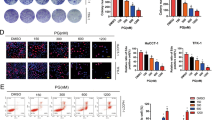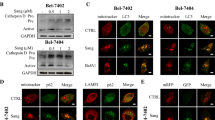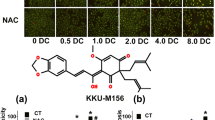Abstract
Norcantharidin is a cantharidin demethylated analog with antitumor effects in many tumors, including cholangiocarcinoma. Autophagy suppression is known to increase chemosensitivity in cholangiocarcinoma. This study aimed to determine whether autophagy suppression accelerates apoptosis induced by norcantharidin in human cholangiocarcinoma cells. The human cholangiocarcinoma cell line QBC939 was incubated in RPMI 1640 medium with or without norcantharidin. Autophagy was induced using HBSS media with Ca2+ and Mg2+ supported by 10 mM HEPES or suppressed by treatment with 3-MA or transfection with siRNA against Atg5. The comparison was drawn between these conditions in mitochondrial membrane potential disturbance, the levels of reactive oxygen species (ROS), apoptotic proteins, and apoptosis. Cholangiocarcinoma cell apoptosis was accelerated by norcantharidin. Autophagy suppression up-regulated norcantharidin’s pro-apoptotic effect, but autophagy induction weakened it. As apoptosis was accelerated, ROS production was up-regulated. Bax protein expression, cytochrome c levels and localization, mitochondrial membrane disturbance, and the levels of caspase-9, caspase-3, and cleaved PARP were higher when autophagy was suppressed, and all of those were down-regulated when autophagy was induced. To sum up, it was found that norcantharidin induced cholangiocarcinoma cell death, and autophagy suppression enhanced the pro-apoptotic action of norcantharidin, which appears to involve the mitochondrial apoptosis pathway activation and ROS generation.







Similar content being viewed by others
Abbreviations
- LC3-II:
-
light chain 3-II
- NCTD:
-
norcantharidin
- 3-MA:
-
3-methyladenine
- HBSS:
-
Hank’s balanced salt solution
- ROS:
-
reactive oxygen species
References
Walden D, Kunnimalaiyaan S, Sokolowski K, Clark TG, Kunnimalaiyaan M (2017) Antiproliferative and apoptotic effects of xanthohumol in cholangiocarcinoma. Oncotarget 8:88069–88078
Guan L, Zhang L, Gong Z, Hou X, Xu Y, Feng X, Wang H, You H (2016) FoxO3 inactivation promotes human cholangiocarcinoma tumorigenesis and chemoresistance through Keap1-Nrf2 signaling. Hepatology 63:1914–1927
Zhang H, Yang T, Wu M, Shen F (2016) Intrahepatic cholangiocarcinoma: epidemiology, risk factors, diagnosis and surgical management. Cancer Lett 379:198–205
Hu MH, Chen LJ, Chen YL, Tsai MS, Shiau CW, Chao TI, Liu CY, Kao JH, Chen KF (2017) Targeting SHP-1-STAT3 signaling: a promising therapeutic approach for the treatment of cholangiocarcinoma. Oncotarget 8:65077–65089
Roskoski R Jr (2017) ROS1 protein-tyrosine kinase inhibitors in the treatment of ROS1 fusion protein-driven non-small cell lung cancers. Pharmacol Res 121:202–212
Thanee M, Loilome W, Techasen A, Sugihara E, Okazaki S, Abe S, Ueda S, Masuko T, Namwat N, Khuntikeo N, Titapun A, Pairojkul C, Saya H, Yongvanit P (2016) CD44 variant-dependent redox status regulation in liver fluke-associated cholangiocarcinoma: a target for cholangiocarcinoma treatment. Cancer Sci 107:991–1000
Wang X, Yu S, Jia Q, Chen L, Zhong J, Pan Y, Shen P, Shen Y, Wang S, Wei Z, Cao Y, Lu Y (2017) NiaoDuQing granules relieve chronic kidney disease symptoms by decreasing renal fibrosis and anemia. Oncotarget 8:55920–55937
Fu H, Wu R, Li Y, Zhang L, Tang X, Tu J, Zhou W, Wang J, Shou Q (2016) Safflower yellow prevents pulmonary metastasis of breast Cancer by inhibiting tumor cell Invadopodia. Am J Chin Med 44:1491–1506
Xiao W, Wu K, Yin M, Han S, Ding Y, Qiao A, Lu G, Deng B, Bo P, Gong W (2015) Wogonin inhibits tumor-derived regulatory molecules by suppressing STAT3 signaling to promote tumor immunity. J Immunother 38:167–184
Chang C, Zhu YQ, Mei JJ, Liu SQ, Luo J (2010) Involvement of mitochondrial pathway in NCTD-induced cytotoxicity in human hepG2 cells. J Exp Clin Cancer Res 29:145
Han W, Wang S, Liang R, Wang L, Chen M, Li H, Wang Y (2013) Non-ionic surfactant vesicles simultaneously enhance antitumor activity and reduce the toxicity of cantharidin. Int J Nanomedicine 8:2187–2196
Yeh CB, Su CJ, Hwang JM, Chou MC (2010) Therapeutic effects of cantharidin analogues without bridging ether oxygen on human hepatocellular carcinoma cells. Eur J Med Chem 45:3981–3985
Sakahira H, Enari M, Nagata S (2015) Corrigendum: cleavage of CAD inhibitor in CAD activation and DNA degradation during apoptosis. Nature 526:728
Rautou PE, Mansouri A, Lebrec D, Durand F, Valla D, Moreau R (2010) Autophagy in liver diseases. J Hepatol 53:1123–1134
Moretti J, Roy S, Bozec D, Martinez J, Chapman JR, Ueberheide B et al (2017) STING senses microbial viability to orchestrate stress-mediated autophagy of the endoplasmic reticulum. Cell 171 e13:809–823
Xiong X, Wu M, Zhang H, Li J, Lu B, Guo Y et al (2015) Atg5 SiRNA inhibits autophagy and enhances norcantharidin-induced apoptosis in hepatocellular carcinoma. Int J Oncol 47:1321–1328
Hou YJ, Dong LW, Tan YX, Yang GZ, Pan YF, Li Z, Tang L, Wang M, Wang Q, Wang HY (2011) Inhibition of active autophagy induces apoptosis and increases chemosensitivity in cholangiocarcinoma. Lab Investig 91:1146–1157
Settembre C, Di Malta C, Polito VA, Garcia Arencibia M, Vetrini F, Erdin S et al (2011) TFEB links autophagy to lysosomal biogenesis. Science 332:1429–1433
Carchman EH, Rao J, Loughran PA, Rosengart MR, Zuckerbraun BS (2011) Heme oxygenase-1-mediated autophagy protects against hepatocyte cell death an hepatic injury from infection/sepsis in mice. Hepatology 53:2053–2062
Lewis JS, Meeke K, Osipo C, Ross EA, Kidawi N, Li T, Bell E, Chandel NS, Jordan VC (2005) Intrinsic mechanism of estradiol-induced apoptosis in breast cancer cells resistant to estrogen deprivation. J Natl Cancer Inst 97:1746–1175
Mavros MN, Economopoulos KP, Alexiou VG, Pawlik TM (2014) Treatment and prognosis for patients with intrahepatic cholangiocarcinoma: systematic review and meta-analysis. JAMA Surg 149:565–574
Lau SH, Lau WY (2012) Current therapy of hilar cholangiocarcinoma. Hepatobiliary Pancreat Dis Int 11:12–17
Estrabaud E, De Muynck S, Asselah T (2011) Activation of unfolded protein response and autophagy during HCV infection modulates innate immune response. J Hepatol 55:1150–1153
Tai H, Wang Z, Gong H, Han X, Zhou J, Wang XN et al (2017) Autophagy impairment with lysosomal and mitochondrial dysfunction is an important characteristic of oxidative stress-induced senescence. Autophagy 13:99–113
Toshima T, Shirabe K, Fukuhara T, Ikegami T, Yoshizumi T, Soejima Y, Ikeda T, Okano S, Maehara Y (2014) Suppression of autophagy during liver regeneration impairs energy charge and hepatocyte senescence in mice. Hepatology 60:290–300
Whitehead NP (2016) Enhanced autophagy as a potential mechanism for the improved physiological function by simvastatin in muscular dystrophy. Autophagy 12:705–706
Xie SQ, Zhang YH, Li Q, Xu FH, Miao JW, Zhao J, Wang CJ (2012) 3-nitro-naphthalimide and nitrogen mustard conjugate NNM-25 induces hepatocellular carcinoma apoptosis via PARP-1/p53 pathway. Apoptosis 17:725–734
Qi F, Inagaki Y, Gao B, Cui X, Xu H, Kokudo N et al (2012) Bufalin and cinobufagin induce apoptosis of human hepatocellular carcinoma cells via Fas- and mitochondria-mediated pathways. Cancer Sci 102:951–958
Shen B, He PJ, Shao CL (2013) Norcantharidin induced DU145 cell apoptosis through ROS-mediated mitochondrial dysfunction and energy depletion. PLoS One 8:e84610
Zhao L, Yang G, Bai H, Zhang M, Mou D (2017) NCTD promotes Birinapant-mediated anticancer activity in breast cancer cells by downregulation of c-FLIP. Oncotarget 8:26886–26895
Fang EF, Scheibye-Knudsen M, Brace LE, Kassahun H, SenGupta T, Nilsen H, Mitchell JR, Croteau DL, Bohr VA (2014) Defective mitophagy in XPA via PARP-1 hyperactivation and NAD(+)/SIRT1 reduction. Cell 157:882–896
Choi BM, Chen XY, Gao SS, Zhu R, Kim BR (2011) Anti-apoptotic effect of phloretin on cisplatin-induced apoptosis in HEI-OC1 auditory cells. Pharmacol Rep 63:708–716
Prenek L, Boldizsár F, Kugyelka R, Ugor E, Berta G, Németh P, Berki T (2017) The regulation of the mitochondrial apoptotic pathway by glucocorticoid receptor in collaboration with Bcl-2 family proteins in developing T cells. Apoptosis 22:239–253
Acknowledgments
The study was financed by grants from the National Science Foundation of China (81670570), Key research and development program of Jiangsu Province (BE2016789).
Author information
Authors and Affiliations
Contributions
YW, XL, WJ, CJ and XX conception and design, or analysis and interpretation of data; YW, WJ, CJ, XX, HG and QT drafting the article; XL is the guarantor for the article.
Corresponding author
Ethics declarations
Conflict of Interest
No conflict of interest was declared by the authors.
Additional information
Publisher’s Note
Springer Nature remains neutral with regard to jurisdictional claims in published maps and institutional affiliations.
Rights and permissions
About this article
Cite this article
Wang, Y., Jiang, W., Li, C. et al. Autophagy Suppression Accelerates Apoptosis Induced by Norcantharidin in Cholangiocarcinoma. Pathol. Oncol. Res. 26, 1697–1707 (2020). https://doi.org/10.1007/s12253-019-00719-9
Received:
Accepted:
Published:
Issue Date:
DOI: https://doi.org/10.1007/s12253-019-00719-9




